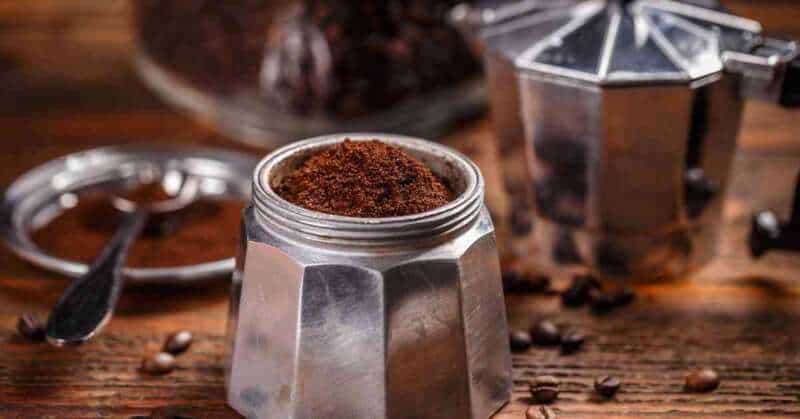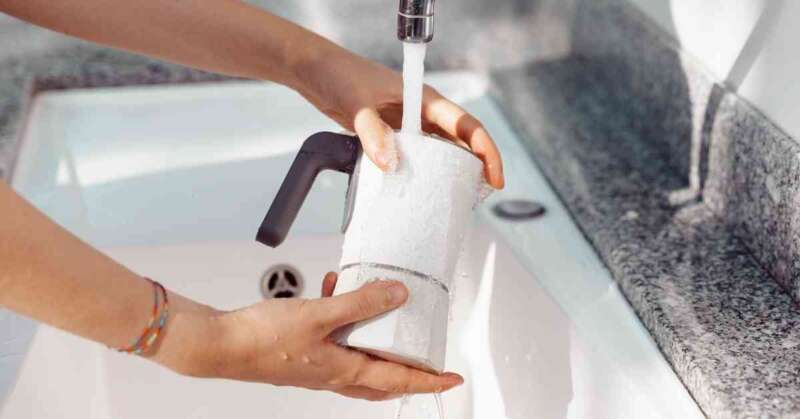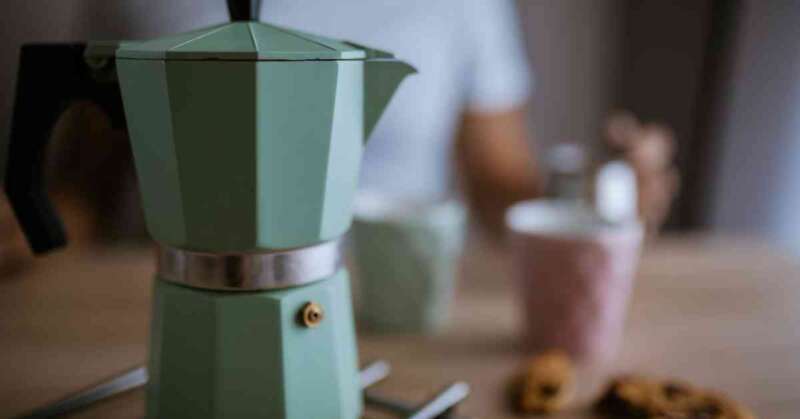If you’ve got a Moka pot, you’re wise to ask how to clean it properly. This task is one that’s often misunderstood, and the internet is full of lots of poor advice on how to clean Moka pot grime.
Some say not to clean it at all – but that’s poor advice!
If you do decide to clean your Moka pot, make sure you read our guide on how to season your Moka pot to get the very best-tasting coffee every time.
When you use your Moka pot, many compounds are deposited, which then oxidize and burn. Many argue that this doesn’t spoil how your fresh coffee tastes, but it does!
A clean Moka pot is essential if you want to make the most of the coffee flavor and have your Moka pot work properly for many years.
So, how do you clean Moka pots? Let’s find out.
What Is Your Moka Pot Made Of?
The first thing you need to know before any cleaning is done is what is your Moka pot made of. Typical espresso makers are available as stainless steel models or aluminum models.
If yours is stainless steel, you’ve got a few more options. You’ll need to be a little more careful if it’s aluminum.
This is because anything acidic in water – even acidic water – can damage the surface of your Moka pot.

Taking Care of The Parts
When you do clean your coffee maker, you’ll need to remove the filter plate or filter basket, funnel, and any rubber seal too. All the parts should be washed regularly.
If the rubber seal is tricky to remove, you can try using the underside of a spoon to prise it off.
Proper cleaning of your rubber seal will make it work for longer, and it won’t be as prone to losing its elasticity or becoming damaged.
Things like rubber seals can easily be replaced, and spare parts are widely available, so make sure you periodically check the seal is doing its job properly.
Is your Moka pot spitting or hissing? Check out our more in-depth guide on how to fix your sputtering Moka pot for a solution.
How to Clean Your Aluminum Moka Pot
Using soap and cold water is the best way to have a clean pot. With aluminum, you’ll need a little more soap due to it being porous.
A small amount of soap will do – just enough to get the Moka pot clean. Avoid over-perfumed soaps or strong chemicals, a mild detergent is what you’re looking for. Another solution you can use is hot water with baking soda.
All the parts need to be cleaned separately, so you’ll need to disassemble the Moka pot.
Ensure you rinse the filter basket thoroughly to get rid of the soap. You can use a dish brush to get any bits of coffee out. Cleaning the funnel can be tricky, but it is important.
Things that Could Cause Damage
Be careful with harsh brushes, though. If you scratch the aluminum, the scratches can become home to micro-ground coffee and rancid oils, affecting your brew taste.
Don’t forget anything acidic like a descaling product, citric acid, or another cleaner will cause the surface to react and become damaged. Moreover, drying the pot with a paper towel or cloth after washing will prevent any stains from appearing.
Never put an aluminum espresso maker in a dishwasher! You should also never use steel wools or abrasive products that will take away the surface layer.
If you don’t look after a coffee maker properly, the taint can affect the coffee. When the surface has been affected, the coffee can have a metallic taste. Thus, for a better tasting coffee brew, never let your coffee maker get tainted or damaged.
Why Use This Metal if It’s so Hard to Maintain?
This metal keeps a thin layer of coffee oils on its surface, which improves the taste. Most Italians would use nothing else!
How to Clean Your Moka Pot if It’s Stainless Steel
It’s not as difficult to clean a stainless steel Moka pot compared to aluminum ones, and you have more options. I still wouldn’t recommend using a dishwasher, however, as these espresso machines need a gentle touch.
You should disassemble the entire pot and wash it with warm water and dishwashing liquid. You might notice that the lower chamber has limescale.
The build-up in this water chamber depends on how hard your water is. We’ll talk about descaling this part later.

The upper chamber can be washed by hand and rinsed to remove all of the leftover coffee grounds.
Because coffee grounds are really small, it’s quite easy for them to get into all of the nooks and crannies of your stovetop espresso maker.
You can clean the sieve or funnel by placing them under running hot water. If you still notice some particles, a cleaning brush can be used.
Making sure your espresso maker is properly clean after each use will give you great coffee every time.
With stainless steel, you can finish with a liquid chrome polish to keep it looking like new.
Magnetized stainless steel Moka pots can be used on Induction stoves. Check out our post on how to use a Moka pot on an Induction stove for more information.
Want to Use More Natural Products on Your Moka Pot?
If you’re keen on avoiding dish soap, you can do all your cleaning with three basic ingredients. These are lemon juice, white vinegar, and baking soda. Citric acid is another useful product. These substances will help to break down the coffee oils and make it easier to remove them.
Moka Pot Descaling
Moka aficionados that live in a hard water area will need to carry out descaling occasionally. Moka pots don’t need descaling as often as espresso machines do but it is still required from time to time.
The danger with not descaling the filter plate is that excess pressure could build up in the lower chamber. A safety valve will deal with the pressure but if this clogs due to limescale, your Moka pot won’t be able to release steam.
Ensuring the safety valve is clear is important. Equally, you should never fill the chamber past the safety valve either as this will render it useless.
How to Descale Your Moka Pot
Distilled white vinegar is the best substance for descaling a Moka pot. This is inexpensive and as well as getting rid of mineral deposits, it cleans, removes odors, and disinfects without trace.
After cleaning your Moka pot using the methods above, wait until it is completely dry before descaling. Use a soft cloth soaked with some vinegar to wipe the outside, you’ll notice just how much it shines too! Rinse it with water and leave it to dry.
Descaling the Inside of Moka Pots
For cleaning the inside of the pot, add 1 part vinegar to two parts water. Put this solution into your coffee maker as though you were going to make a brew. However, don’t add in any coffee grounds!
When you’ve assembled everything, put the Moka Pot on the stove on a low heat. Wait until the vinegar solution has boiled through and passed into the upper chamber, then turn the heat off and allow it to cool.
After it has cooled, repeat this cleaning process just with water, this time to rinse it through. Finally, rinse all parts with clean tap water, and your descaling will be complete.

Final Thoughts
Cleaning your pot is important and is a part of looking after it properly (and getting the best coffee). Remember that the material matters.
If you’ve got an aluminum espresso pot, you’ll need to be particularly careful not to tarnish it when you wash it. Rinsing with warm water or hot water immediately after use will help keep things fresh.
There are a few other things you’ll need to ensure. Firstly, always use full measures when making coffee. Never fill it half full, as it is not designed to work with so little water. If you half-fill the chamber, you won’t have a great coffee.
Also, it goes without saying that Moka pots are designed to be used with ground coffee only and should never be used with instant coffee. You should really use coffee grounds specifically for Moka pots too.
Finally, if you live in a hard water area, you should consider using filtered water to avoid limescale build-up. Filtered water also makes coffee better.
